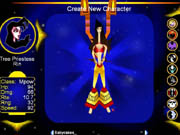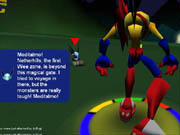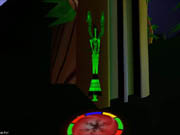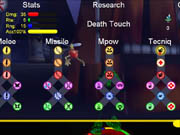Massively multiplayer online gaming is inherently unstable. Such games are typically released in an unfinished state as developers take advantage of a public that now expects such games to be works-in-progress. This trend has grown to the point where some online games have been barely functional on arrival. World War II Online showed up on its scheduled release date on June 6 last year but required a huge patch that replaced almost everything on the game CD before you could even begin playing. Even then, the game was bug-ridden and lacked many promised features. Anarchy Online hit stores at the end of that same month with stability issues, major lag, CD key problems, and, to top things off, a credit card registration system that initially wasn't handled on a secure server. It's hard to imagine an online game launch that could go any worse than those two.

Well, it used to be hard to imagine that. The launch of Fighting Legends, a real-time strategy/role-playing hybrid from independent development house Maximum Charisma Studios, has been even more disastrous. Bugs have been prevalent from the very beginning, and a flawed registration system and continual server problems make it a struggle just to get into the game. When you finally do fight your way inside, a combination of connection drops, bugs and associated anomalies, a half-baked game design, and a frustratingly obtuse world make you quickly decide that the battle isn't worthwhile. This is perhaps the ultimate example of an incomplete online game with more glaring defects than properly working features.
Cracks are evident right in the foundation. Bugs were so prevalent in the initial release that the game was unplayable. Just registering took more than six hours, spread over two days, as the menu system kept running into "page not found" dead ends. You would think that the system that allows the company to collect its $9.99 monthly fee would be the first thing to be checked out. Calls to Maximum Charisma's support line did little but run up our long-distance phone bill. Twenty-minute waits on hold were followed with generic advice about getting the most recent video card driver updates and the promise of a promptly e-mailed support guide (which didn't show up until the next day). The system never did work properly, although immoderate use of the refresh and forward buttons in our browser somehow got us through.

But it didn't get us playing. After completing the sign-up process and creating a character, everything ground to a halt on the opening screen. Our character moved as instructed for a few seconds and then froze. Forward or backward movement was impossible from that point on, although the character could be rotated in place. All other keys functioned normally, and the gameworld continued to turn. Technical support couldn't resolve this problem--nor could more than a week of phone conversations and correspondence with Maximum Charisma's top troubleshooter, consultations with our local ISP, numerous driver changes, and finally reinstalling the Windows 98 operating system. Only switching to a completely new machine and Windows XP finally got the game running. As usual with this sort of thing, there is no way to tell what caused the glitch or even whether it was fixed by the system change or something that Maximum Charisma added to one of its regular updates. Connection problems lingered, though, and the entire system went down numerous times, including a lengthy interruption in service around the holidays. Instability remains a serious concern.
When we were able to play Fighting Legends, it quickly became apparent that the design was intended to give online gamers something new and different. Maximum Charisma certainly delivers in that regard, though the company has gone so far beyond what people expect of a massively multiplayer game that the results are nearly incomprehensible. The setting is the planet Exisle, following the crash of a "giant robotic entity" known as Lergan, "the cosmic seed." This crash, which was apparently caused by a mechanical spider-janitor that had succumbed to space madness (uh-huh), freed all sorts of creatures from their suspension in "cryojuice." Or killed them. The back story isn't very clear on this point, and there's some mention of ghosts. What is clear is that the scriptwriters should switch off the anime.
At any rate, the survivors have formed into nine clans split among the Sky Realm, Surface Plain, and Underworld regions of Exisle. The Sky Realm is home to the Rin, Pyron, and M-Clan, while the Surface Plain features the Humans, Bear-Kats, and Bio-Mechs. The Underworld hosts the Bone Clan, Arachin, and Wee. Clan territories are separate entities that can be entered only through magical gates. Characteristics of the clans in each area roughly correspond to role-playing game alignments and the elements. The Rin, for example, are good nature lovers who use ranged weapons, while the evil Pyron are fiery warmongers. The neutral M-Clan is composed of icy magic users. You begin play by creating an avatar from one of these clans and choosing which of five archetypes to represent. Archetypes are similar to role-playing character classes. Melee characters emphasize close-quarters combat skills, MPow focus on magic, Techniq look after healing allies, Missile are best with ranged weapons, and Speed is a catch-all that takes one of the other categories and adds swiftness. Six character statistics track things such as damage ability and hit points. These scores cannot be altered initially, although you do collect experience points and level up in the same fashion as in a typical role-playing game.

The gameplay itself isn't typical. Although you guide a character around a persistent world, the focus of play blends elements of real-time strategy with role-playing. You must deploy a base, gather resources, build huts and defensive structures, and summon squad members. It is the center of all activity, including the resurrection of your avatar when necessary. Quests, treasure, and nonplayer characters exist, but the guiding premise is an ongoing war between the clans in each region of Exisle. Each group has a natural enemy, so the intent of the designers is obviously to provoke rivalries that lead to base building and combat.
It doesn't work out that way. For starters, the real-time strategy aspects are just trappings. Bases are usually deployed temporarily for the specific purpose of recruiting troops for a squad or to resurrect your avatar. Once this is done, you can tuck away the buildings with the click of a button. Base construction is also extremely expensive. You need 400 resource points to build an average structure, yet slaying the typical enemy in the early stages of the game nets you no more than two or three. It takes a very, very long time to get to the point where you can deploy most of the base huts and raise a significant army. The first dozen or so hours see you mainly wandering Exisle in search of monsters to kill for cash and experience points. This quickly gets tedious. Aside from the clunky third-person combat system, the planet is vast and sparsely populated. More time is spent running across North Dakota-sized plains than battling enemies. Other human players are also absent. It's nearly impossible to find another person playing Fighting Legends. The lone saving grace here is that most people won't get far enough into the game for their hermitlike status to become a cause for complaint.

The appearance of this seemingly limitless terrain isn't for everyone. To complement the Japanese pop-culture storyline, Maximum Charisma gave Fighting Legends a distinctive cartoon look. Characters resemble Pokémon monsters in many respects. The lineup includes all manner of cutesy creations that look like toys, from the fluffy Bear-Kats to robot frog Bio-Mechs. The 3D acceleration and use of bright, primary colors give the game a cheerful sheen, though this leans toward the garish, and too many scenes are devoid of features. Shoddy collision detection causes objects to pop up in the middle of walls and characters' feet to sink into the ground on hills. Certain of these troublesome areas can cause you to get stuck. Audio effects are also cartoonlike but vivid and effective. Monster roars and howls are distinctive, as are atmospheric sounds, such as crickets chirping at night and rain pouring down. The musical score is appropriately spacey and lighthearted.
Fighting Legends could have used at least another year in development. While the initial concept was a fascinating one--not to mention a much-needed alternative to the fantasy role-playing online monopoly--Maximum Charisma didn't take enough time to ensure that the design was solid and that the code and the company's servers could handle the operation of a persistent-world game. There remains some promise here, although the absence of a devoted following makes the future of this game cloudy at best.